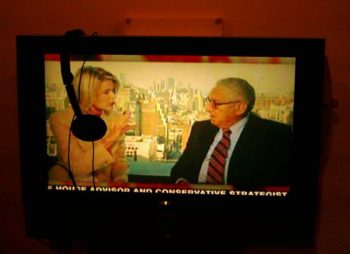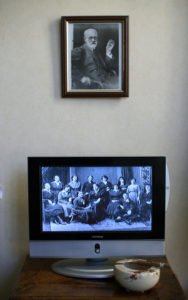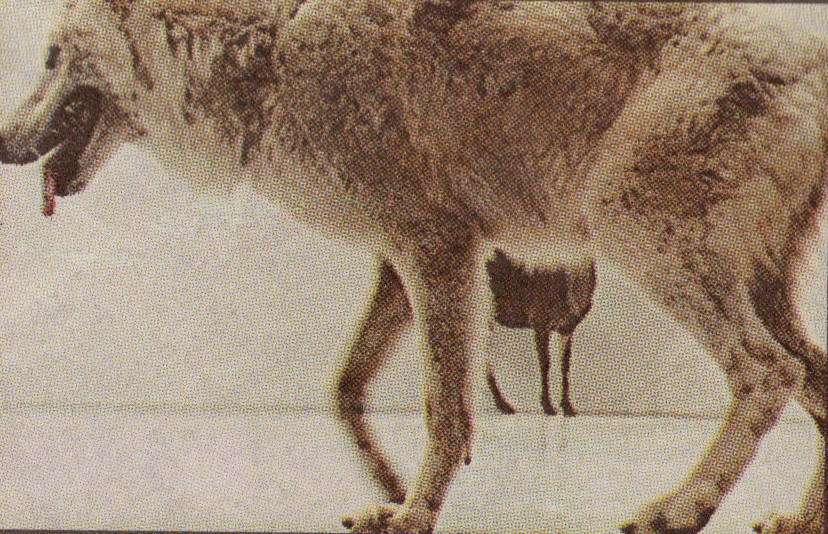Paranoia is the terrifying fear of being hurt.
Paranoia is a false accusation pretending to be real.
Paranoia is the accuser side of the false or unreal self. The feeling is real but the characters are displaced and substituted. The accused is merely a stand-in for the real person.
Paranoia needs an enemy, but can’t seem to find the real persecutor. So, anyone will do.
Paranoia victimizes the innocent by accusing them of being guilty of harmful actions that never occurred in the first place.
Paranoia claims that you are guilty before the trial and the probability of your innocence is denied and rejected.
Paranoia thrives in an inner universe of intensely walled off, suppressed and repressed hurt and pain.
Paranoia is based on the rejection, denial and suppression of vital parts of the self.

Untitled [Veteren’s Day], Jeremy Deller
Fictional apocalyptic stories are worryingly similar to everyday reality, causing increasing fear and creating a climate of anxiety. When does the mind become paranoid?
This exhibition illustrated the proximity of art and life against the backdrop of contemporary politics exploring issues of distrust, suspicion, delusion, fear and terror.
 Presented were works of international artists exploring the essence of paranoia as one’s deluded interpretation of events, not the perception of the events themselves. The artists who exhibited in Paranoia are from diverse ethnic and cultural backgrounds, many from the world’s areas of conflict. The exhibition incorporated digital technology, conceptual work, performance, photography, video, installation and drawing to reflect the collective sense of dismay over the stupidity, prejudice and superstition engendered by the ‘war on terror’ in a post-9/11 world.
Presented were works of international artists exploring the essence of paranoia as one’s deluded interpretation of events, not the perception of the events themselves. The artists who exhibited in Paranoia are from diverse ethnic and cultural backgrounds, many from the world’s areas of conflict. The exhibition incorporated digital technology, conceptual work, performance, photography, video, installation and drawing to reflect the collective sense of dismay over the stupidity, prejudice and superstition engendered by the ‘war on terror’ in a post-9/11 world.
A Note on the Exhibition: Freud and Paranoia
Why Paranoia?
“A man who does not lose his reason over certain things can have no reason to lose.”
Sigmund Freud, 1895 (letter to Wilhelm Fliess)
Freud not only wrote about paranoia, he was also a victim of paranoia. He came to this house as an exile from the Nazis. Paranoia was the glue that held the Nazi ideology together. The ‘dirty’ Jews and other ‘degenerates’ would infect you with disease and destroy the purity of blood; the conspiracy of Jewish bankers would take over the fatherland and enslave you. 45 years earlier he had predicted the mechanism by which he, his fellow Jews, homosexuals, the disabled, Gypsies, Communists and others would be demonised and made to take the blame for past humiliations and everything ‘bad’ in society. He wrote:
“The purpose of paranoia is to ward off an idea that is incompatible with the ego, by projecting its substance into the external world” …. “The grande nation cannot face the idea that it could be defeated in war. Ergo it was not defeated; the victory does not count. It provides an example of mass paranoia and invents the delusion of betrayal”
(Letter to Wilhelm Fliess, 1895)
 From the very beginning, Freud saw paranoia in its psychical and social dimensions. Today, with very real threats that surround us, there are politicians eager to exaggerate them and create a climate of irrational fear. Even paranoids have enemies, as Golda Meir once said; but people who have enemies may also be paranoid. How do we distinguish between real threats and paranoid anxiety?
From the very beginning, Freud saw paranoia in its psychical and social dimensions. Today, with very real threats that surround us, there are politicians eager to exaggerate them and create a climate of irrational fear. Even paranoids have enemies, as Golda Meir once said; but people who have enemies may also be paranoid. How do we distinguish between real threats and paranoid anxiety?
Political paranoia finds its home in systems of belief and feeds on any form of fundamentalism. A sense of threat stabilizes community identity. We feel righteous and we know we are right. That which is expunged from the community becomes alien, sub-human, other. When Freud’s books were burned by the Nazis in 1933, they announced:
“Against the soul-destroying glorification of the instinctual life, for the nobility of the human soul! We consign to the flames the writings of the school of Sigmund Freud.”
How can we escape the paranoid fears that tear communities apart? The exhibition presents illustrations and examples – it does not offer an answer. The only answer can come through seeing and understanding.
In his later work Freud would have translated this as (referring to the example of inter-War Germany): ‘The nation cannot face the idea that it has been ‘emasculated’ in war; ergo it was not emasculated. It was betrayed by those who really are emasculated (Jews, women etc)’.
Paranoia definitions
“Functional psychosis characterised by delusions of grandeur and persecution, but without intellectual deterioration. In classic cases of paranoia, the delusions are organised into a coherent, internally consistent delusional system on which the patient is prepared to act.” (Rycroft, Charles (1968) A Critical Dictionary of Psychoanalysis London: Penguin)
Laplanche and Pontalis offer:
“Chronic psychosis characterised by more or less systematised delusion, with predominance of ideas of reference but with no weakening of the intellect…” (J. Laplanche and J-B Pontalis (1973) The Language of Psychoanalysis trans: Donald Nicholson-Smith London: Hogarth Press and the Institute of Psychoanalysis p. 296)
“The psycho-analyst, in the light of his knowledge of the psychoneuroses, approaches the subject with a suspicion that even thought-structures so extraordinary as these and so remote from our common modes of thinking are nevertheless derived from the most general and comprehensible impulses of the human mind… (Freud, 1911)
Why is Paranoia important for Freud?
Reality
Freud was keenly aware of the fragility of our grasp on reality. It comes apart in dreams, and even in waking life the ‘internal world’ of our fantasies and emotions continually interferes with our perception. What we call ‘reality’ is mediated by language and because of that, it is no longer clear whether it comes from the inside or the outside.
In his last work, written in London, he writes:
“In man there is an added complication through which internal processes in the ego may also acquire the quality of consciousness. This is the work of the function of speech, which brings material in the ego into a firm connection with mnemic residues of visual, but more particularly of auditory, perceptions. Thenceforward the perceptual periphery of the cortical layer can be excited to a much greater extent from inside as well, internal events such as passages of ideas and thought-processes can become conscious, and a special device is called for in order to distinguish between the two possibilities – a device known as reality-testing. The equation ‘perception = reality (external world)’ no longer holds. Errors, which can now easily arise and do so regularly in dreams, are called hallucinations.”
(Freud 1938)

Departure, 2006, Cantor
As with reality, so with the idea of ‘truth’.
“It has not been possible to demonstrate … that the human intellect has a particularly fine flair for the truth or that the human mind shows any special inclination for recognizing the truth. We have rather found, on the contrary, that our intellect very easily goes astray without any warning, and that nothing is more easily believed by us than what, without reference to the truth, comes to meet our wishful illusions.” (Freud, 1937)
“I believe that a large part of the mythological view of the world, which extends a long way into the most modern religions, is nothing but psychology projected into the external world. The obscure recognition… of psychical factors and relations in the unconscious is mirrored – it is difficult to express it in other terms, and here the analogy with paranoia must come to our aid – in the construction of a supernatural reality, which is destined to be changed back once more by science into the psychology of the unconscious. One could venture to explain in this way the myths of paradise and the fall of man, of God, of good and evil, of immortality, and so on, and to transform metaphysics into metapsychology.” (Psychopathology of Everyday Life, 1901, S.E. 6 pp. 258-259)
Projection
“The purpose of paranoia is thus to ward off an idea that is incompatible with the ego, by projecting its substance into the external world” (Draft H, p109).
The woman whose sexuality is aroused in an unacceptable way is suddenly aware that her neighbours are gossiping about her. The self reproach of being a ‘slut’ has been projected into the outside world. Or “The alcoholic will never admit to himself that he has become impotent through drink … So his wife is to blame.” (Draft H, p110). “The official who has been passed over for promotion requires that there is a conspiracy against him and that he be spied on in his room. Otherwise he would have to admit his shipwreck” (Draft H, p110) And most tellingly, a prescient example from the socio-political field: “The grande nation cannot face the idea that it could be defeated in war. Ergo it was not defeated; the victory does not count. It provides an example of mass paranoia and invents the delusion of betrayal” (Draft H, p110)
Scapegoating
Let us say it is not us who have been humiliated by defeat or failure; it is our dead fathers instead. Our relationship to the father is ambivalent – conscious affection and unconscious hatred. We blame the father for the defeat – for failing to live up to our ideals of him – but we fear him also. We solve this psychical dilemma by projecting our hatred into the ‘other’ who then becomes the justifiable object of our aggression and fear. Freud describes this process in Totem and Taboo (Chapter II ‘Emotional ambivalence’)
“It is no longer true that they are rejoicing to be rid of the dead man; on the contrary, they are mourning for him; but strange to say, he has turned into a wicked demon ready to gloat over their misfortunes and eager to kill them. It then becomes necessary for them, the survivors, to defend themselves against this evil enemy; they are relieved of pressure from within, but have only exchanged it for oppression from without.” (p63)
Being watched
It would not surprise us if we were to find a special psychical agency which… constantly watches the actual ego and measures it by [its] ideal… Recognition of this agency enables us to understand the so-called ‘delusions of being noticed’ or more correctly, of being watched, which are such striking symptoms in the paranoid diseases and which may also occur as an isolated form of illness, or intercalated in a transference neurosis. Patients of this sort complain that all their thoughts are known and their actions watched and supervised; they are informed of the functioning of this agency by voices which characteristically speak to them in the third person (‘Now she’s thinking of that again’, ‘now he’s going out’). This complaint is justified; it describes the truth. A power of this kind, watching, discovering and criticizing all our intentions, does really exist. Indeed, it exists in every one of us in normal life.
…For what prompted the subject to form an ego ideal, on whose behalf his conscience acts as watchman, arose from the critical influence of his parents (conveyed to him by the medium of the voice), to whom were added, as time went on, those who trained and taught him and the innumerable and indefinable host of all the other people in his environment – his fellow-men – and public opinion. (‘On Narcissism: An introduction’ SE 14, p. 95-96)
Inclination to aggression
‘The element of truth behind all this, which people are so ready to disavow, is that men are not gentle creatures who want to be loved, and who at the most can defend themselves if they are attacked; they are, on the contrary, creatures among whose instinctual endowments is to be reckoned a powerful share of aggressiveness. As a result, their neighbour is for them not only a potential helper or sexual object, but also someone who tempts them to satisfy their aggressiveness on him, to exploit his capacity for work without compensation, to use him sexually without his consent, to seize his possessions, to humiliate him, to cause him pain, to torture and to kill him. Homo homini lupus. Who, in the face of all his experience of life and of history, will have the courage to dispute this assertion? … Anyone who calls to mind the atrocities committed during the racial migrations or the invasions of the Huns, or by the people known as Mongols under Jenghiz Khan and Tamerlane, or at the capture of Jerusalem by the pious Crusaders, or even, indeed, the horrors of the recent World War – anyone who calls these things to mind will have to bow humbly before the truth of this view.’ (Civilization and its discontents 1930)
‘It is clearly not easy for men to give up the satisfaction of this inclination to aggression. They do not feel comfortable without it. The advantage which a comparatively small cultural group offers of allowing this instinct an outlet in the form of hostility against intruders is not to be despised. It is always possible to bind together a considerable number of people in love, so long as there are other people left over to receive the manifestations of their aggressiveness. … In this respect the Jewish people, scattered everywhere, have rendered most useful services to the civilizations of the countries that have been their hosts; but unfortunately all the massacres of the Jews in the Middle Ages did not suffice to make that period more peaceful and secure for their Christian fellows. When once the Apostle Paul had posited universal love between men as the foundation of his Christian community, extreme intolerance on the part of Christendom towards those who remained outside it became the inevitable consequence. (Civilization and its Discontents, 1930).
Daniel Baker
Gypsies are still very much seen as unreal people. They are seen either as a romantic ideal from the past or as the thief, the villain, the dirty people that will pull their trailer onto your cricket ground and make a mess, a personification of evil if you like.
(From an interview with Daniel Baker)
Jeremy Deller
I think that inasmuch as 9/11 was an affront to Americans personally as individuals and to their country it was almost that they were embarrassed to be caught out like that. This is a way for them to feel better about being themselves in that country. It’s a real celebration about America and American values. When you look at the photographs, that comes out. You can either interpret it as being incredibly sinister, or quite funny, or both. When I show the photographs to Americans they laugh, but when I showed them in France the French gasp. (From an interview with Jeremy Deller)
Doug Fishbone
I used some of the most disturbing material imaginable, which curls even my toes when I watch it, I can’t believe I did that. My idea was to offend the audience and manipulate the viewer by giving them a sub-story and winning them back. Something like: I was abused when I was a kid, my mum was a drunk, all these things. I wanted to see how much one could get away with using a visual overload. There are about 480 images squeezed in 11 minutes. It is a kind of video barrage, like being bombarded with ads while on tube escalators, which I can’t stand. This is why I use a satire way of critique while narrating but in a way that is hardly noticeable. (From an interview with Doug Fishbone)
Juul Honduis
What struck me most during my travels is that, at the end of the day what unites people, no matter where they come from, is the struggle to survive and to try to make the best of it along the way. (From an interview with Juul Hondius)
Khaled D. Ramadan
As the world looks today, I can confidently say that I am an unidentified subject. That is the way it is, if you are an Arab living in the West, in a time where words have lost their meanings and significance, in a time where human rights means torture and egalitarianism means authoritarianism. (From an interview with Khaled Ramadan)
The Arab media learned from the western media that democracy is not that essential in contemporary broadcasting. Not in terms of war, nor in terms of peace. What matters is how to serve and mobilize your community against outside messages.
(From ‘Cyber and Air Sphere Colonialism’ by Khaled Ramadan)
Paul Ryan
It becomes a habit, so if you are used to having a daily cycle where you are terrified or worried by the things around you, and then seek out the details about it, you will begin to look forward to your little bit of terror every day. It’s a habit. (From an interview with Paul Ryan)
Related Resources
See the related worksheets produced by the Education department